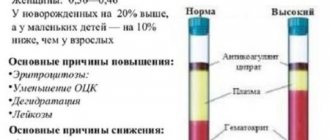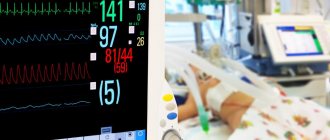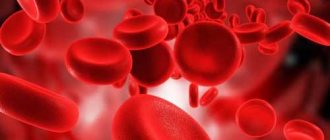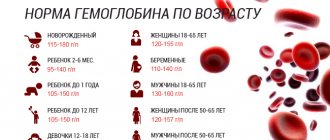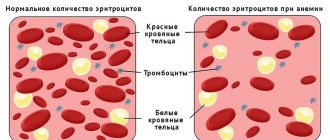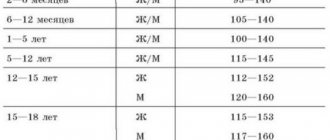You are here: Blood test -
Hemoglobin -
High hemoglobin in a child
- Etiology
- Symptoms
- Diagnostics
- Treatment
- Possible complications
- Prevention and prognosis
High hemoglobin in a child is a laboratory sign determined only on the basis of a general clinical blood test. The disorder develops regardless of age category. The peculiarity of the condition is that it is not always a manifestation of pathology.
The most common sources of disturbance are diseases, dehydration, or the influence of stressful situations. In adolescents, this may be due to bad habits and irrational use of medications.
With a significant increase in the concentration of iron-containing protein, symptoms such as drowsiness and pale skin, blue lips and fingertips, frequent bruising, headache and poor appetite occur.
Since it is impossible to find out the cause of the disorder based on a general blood test, the diagnostic process must necessarily have an integrated approach.
Treatment of high hemoglobin in the blood of a child is limited to following a gentle diet and using folk remedies. Teenage children may need to take medication.
Etiology
Elevated hemoglobin in a child is considered as such if the upper normal values are exceeded by 20–30 units. It is worth noting that normal values may vary slightly depending on age.
| Age category | Upper normal value (g/l) |
| Newborns | 240 |
| 1 week of life | 215 |
| 2 weeks | 205 |
| 1 month | 180 |
| 2 months | 140 |
| Up to six months | 135 |
| From 6 months to a year | 130 |
| From 5 years and older | 140 |
An increase in hemoglobin concentration in a newborn can be facilitated by:
- timing of birth (term or prematurity);
- multiple pregnancy;
- general health of the fetus;
- intrauterine hypoxia;
- premature ligation of the umbilical cord.
After birth, the causes of high hemoglobin may be as follows:
- cardiopulmonary failure;
- diseases of the hematopoietic system;
- intestinal obstruction;
- diabetes;
- the presence of congenital heart defects;
- kidney pathologies;
- neoplasms of a malignant course - their location does not matter;
- hypertonic disease;
- allergic reactions;
- pulmonary fibrosis;
- polycythemia vera;
- dysbacteriosis;
- hypovitaminosis;
- autoimmune diseases.
Sources of high hemoglobin in children are not in all cases associated with the course of diseases. It is not uncommon for such a condition to occur due to harmless reasons:
- insufficient fluid intake;
- increased sweating;
- living in areas with thin air, i.e. in the mountains;
- air pollution;
- excessive physical activity;
- the influence of stressful situations or severe nervous tension;
- smoking - this factor should be attributed to adolescents and those infants whose mothers did not give up the bad habit during pregnancy or breastfeeding.
It is noteworthy that increased hemoglobin in infants and children under 1 year of age is a completely normal condition. The substance is called fetal and gradually decreases on its own to normal levels. By the first year of life, fetal hemoglobin is completely destroyed and replaced by adult hemoglobin.
High hemoglobin in a child: what to do
- in babies under 1 month of age, the norm ranges from 125-225 g/l;
- at one month of age these figures are 100-180 g/l;
- at two months of age, the protein level decreases and can reach its minimum: 90-140 g/l. Then the hemoglobin level begins to gradually increase;
- for the next 3 months of the child’s life, iron-containing protein should be in the range of 95-135 g/l;
- from 6 months to one year the normal value should be 100-140 g/l;
- up to two years of age the norm is: 105-145, up to six years of age - 110-150, up to twelve years of age - 115-150;
- starting from the age of thirteen, the level of iron-containing protein should be within the range of 115-160 g/l.
Did you know? A child's heart pumps about 7,000 liters of blood per day.
It should be noted that in male adolescents, an increase in hemoglobin levels to 170 g/l is allowed. Doctors say that for girls over 16 years of age, protein levels should not exceed 150 g/l.
When the level of iron-containing protein in the blood of children increases, it means that some systems or organs do not have enough oxygen. A high level of hemoglobin makes the blood thicker, as a result of which its permeability through the blood vessels is reduced. Blood clots and blockages can form, and oxygen stops flowing to hard-to-reach places (for example, the tip of the nose, where the arteries have too small a cross-sectional area).
Important! Do not self-medicate your child. At the first sign of deviation, you should seek advice from an experienced specialist.
Protein in red blood cells tends to bind to carbon dioxide, and this bond is hundreds of times stronger than oxygen. When a large amount of poisonous gases enters the body, red blood cells begin to bind to it, and there is little free protein left to carry oxygen.
In such cases, the bone marrow receives a signal about an excess of red blood cells, the production of new ones begins, and as a result, an increase in hemoglobin mass (red blood cell level) per unit volume of blood.
Normal levels of transport protein in red blood cells depend on the number of completed years of the baby, as well as his body weight. The table below presents average data that is considered optimal for children of a particular age group.
| Child's age | Normal values, g per 1 liter of blood |
| 1 to 3 days after birth | From 145 to 225 |
| From 3 to 6 months. | From 95 to 135 |
| From 6 to 12 months. | From 105 to 140 |
| From 1 year to 5 years | From 100 to 140 |
| From 5 to 12 years | From 115 to 150 |
| Children over 12 years of age | From 115 to 160 |
When deciphering the results of a capillary blood study, the attending pediatrician or pediatric hematologist takes into account the number of full years of the child and performs a comparative analysis of the data obtained with the age indicators in the table.
Increasing the above standards is the basis for conducting a comprehensive diagnosis of the child’s entire body in order to establish the causes of excessive synthesis of red cells and hemoglobin.
Vessels and ducts of internal organs are damaged. The child has the following symptoms:
- dilatation of the saphenous veins, which increase in diameter by 2 times (this pathological sign is clearly visible in the neck area);
Increased hemoglobin in a child’s blood leads to a dangerous disease - hemosiderosis. - the surface of the tongue and lips has a bluish tint;
- a change in the color of the sky, which takes on a deep red color;
- the child complains of constant itching of the skin, and scratches appear on its surface (at least 40% of children with signs of increased hemoglobin suffered from this symptom, the manifestation of which increased after bathing in hot water);
- a sensation of short-term burning pain, which is localized in the area of the fingers and toes (this phenomenon is called erythromelagia, accompanied by the formation of purple spots on the skin of the lower and upper extremities);
- during palpation of the abdominal cavity, an increase in the volume of the spleen is determined, and the child is given a concomitant diagnosis - splenomegaly;
- the child complains of an acute feeling of pain in the area of the stomach and duodenum, which is associated with inflammation of the mucous membrane of these organs, as well as the possible appearance of ulcers;
- there is acute pain in the right hypochondrium, which is accompanied by an increase in liver tissue, as well as their excessive blood supply;
- hardening of the veins in the legs and the formation of blood clots;
- bleeding gums and dilation of the veins of the esophagus (if the latter symptom cannot be determined independently, then parents can see the painful condition of the gums when examining the child’s oral cavity);
- cerebrovascular accident, which is accompanied by severe headache, sudden loss of consciousness, dizziness, convulsions, inhibition of the nervous system;
- the results of a biochemical analysis of urine indicate an increase in the level of uric acid;
- the child complains of aching pain in the legs below the knee, where the tubular bones are located.
General malaise and constant physical fatigue appear. The child becomes lethargic, capricious, and wants to sleep all the time. There may be an increase in blood pressure and the appearance of migraine attacks, which are accompanied by short-term visual impairment. Arrhythmia, shortness of breath, and signs of heart and kidney failure may occur.
The following reasons are identified for a sudden increase in protein compounds in red blood cells:
- violation of the drinking regime, when, due to the inexperience or irresponsibility of the parents, a small child does not receive enough water;
- chronic renal failure or inflammatory diseases of this organ;
- thermal and chemical burns of large areas of the body;
- congenital heart defects and bronchopulmonary tissue;
- intestinal obstruction caused by the development of the gastrointestinal tract, or is a complication of concomitant diseases of internal organs;
- smoking and use of anabolic steroids (this reason is often found in adolescent children);
- oncological diseases of the hematopoietic system, which have not yet been diagnosed and are in a latent state;
- dehydration caused by increased sweating;
- stressful situations and prolonged psycho-emotional stress.
The most dangerous cause of elevated hemoglobin in children of all age groups is leukemia. This is an oncological disease in which white blood cells - leukocytes - dominate over red blood cells, and the synthesis of the latter cells rapidly decreases. The disease is caused by a pathological condition of the bone marrow, which does not fully perform its previous functions.
- increased fatigue, drowsiness, moodiness;
- decreased mental activity;
- nausea, headaches, vomiting, dizziness, sudden loss of consciousness;
- bruises that form on the skin after strong pressure or minor bruises;
- purple spots appear on the arms and legs, the nature of which cannot be determined;
- the child complains of a rapid heartbeat, lips, tongue and oral mucosa acquire a cherry or bluish tint;
- increased blood pressure, shortness of breath and signs of vegetative-vascular dystonia.
An increase in the concentration of red cells and a protein compound that performs the function of delivering oxygen to the tissues of the whole body can be detected accidentally during a routine medical examination. After detecting high hemoglobin levels, the attending physician takes measures aimed at establishing the reasons that caused changes in the cellular composition of the blood.
After receiving the results of a capillary blood analysis, a pediatrician or pediatric hematologist performs a comparative analysis taking into account the following indicators:
- clinical level of platelets, leukocytes and erythrocytes, as well as a possible change in their concentration towards increase;
- degree of blood viscosity and its density;
- the patient's potential tendency to form thrombosis;
- visual signs of increased hemoglobin, in the presence of which the child’s color shade of the oral mucosa changes, the spleen and liver tissue enlarge;
- The level of vitamin B12 in the blood serum is taken into account, as well as the concentration of alkaline phosphatase.
Symptoms
The main danger of the disorder is that young children cannot verbally describe or accurately convey to adults what exactly is bothering them or where it hurts. For this reason, parents should be especially attentive to those children who have not yet reached the age of 3 years.
Plus, the disorder has nonspecific symptoms, which can be either mild or veiled clinical manifestations of the underlying disease.
Experts identify symptoms that unmistakably indicate that hemoglobin in the blood is higher than normal. Main features:
- fast fatiguability;
- weakness and lethargy;
- increased drowsiness or, conversely, problems falling asleep;
- redness or excessive pallor of the skin;
- frequent and easy bruising or bleeding;
- increase in blood pressure;
- heart rhythm disturbance;
- poor appetite and breast refusal;
- bluish lips;
- coldness of the fingertips of the upper and lower extremities;
- problems with emptying the bladder and bowels;
- headaches, muscle and joint pain;
- severe dizziness, up to short-term loss of consciousness;
- tearfulness and irritability;
- deterioration of hearing and vision;
- nausea that does not lead to vomiting;
- frequent mood changes;
- weight loss;
- the appearance of blood impurities in the stool;
- absent-mindedness and memory impairment, which leads to learning problems;
- heaviness, pain and distension in the abdomen.
If your child has one or more symptoms, you should consult your pediatrician as soon as possible. This will help avoid the development of dangerous complications.
How to adjust hemoglobin levels with medication?
- Diet. The patient is advised to avoid eating foods that increase iron protein levels or retain iron in the body.
- Taking medications. Prescribed exclusively by a doctor and after a blood test.
- Hirudotherapy. Treatment with leeches brings a positive effect, since the saliva of these creatures contains substances that normalize the composition of the blood. Special components reduce plasma viscosity and prevent blood from clotting too quickly.
- Blood transfusion. The procedure involves taking blood, freeing it from red blood cells and returning it to the patient. If the patient is not sick, it is better to control elevated hemoglobin by donating blood.
- Folk methods. Often alternative medicine is no less effective than medications.
Diagnostics
The fact that the child has an increased level of the most important blood component is confirmed by a general clinical study of biological fluid. Material for research is collected from a finger or from a vein. The procedure has no age restrictions. To obtain the most accurate result, the analysis should be performed several times.
It is important to remember that laboratory diagnostics will only show changes in the blood, but will not be able to identify the provoking factor. To find out the cause of the disorder, a comprehensive examination of the body is necessary.
Primary diagnosis includes:
- familiarization with the medical history - to identify the underlying disease;
- study of family history - to establish the influence of burdened heredity;
- collection and analysis of life history;
- a thorough physical examination;
- assessment of the condition of the skin and mucous membranes;
- measuring temperature, heart rate and blood tone;
- a detailed survey of parents is necessary to draw up a complete symptomatic picture, which in some situations may indicate a provoking disease.
An additional laboratory and instrumental diagnostic program is compiled individually - the clinician relies on complaints, the child’s condition and information obtained during diagnostic measures.
Treatment
High hemoglobin in a child is completely normalized only in situations where the underlying disease is treated, which can be done using conservative or surgical methods, but more often it is complex.
The basis for correcting increased concentrations of iron-containing protein is:
- taking medications;
- maintaining a gentle diet;
- use of traditional medicine recipes.
Therapeutic nutrition involves a complete abstinence from consuming foods fortified with iron. The following are completely excluded from the children's menu:
- red berries, vegetables and fruits;
- offal;
- nuts and dried fruits;
- fatty varieties of meat and fish;
- butter;
- any sweets and eggs;
- carbonated drinks and coffee;
- legumes and mushrooms;
- greens and spinach;
- strawberries;
- grape;
- pomegranate;
- bananas;
- plums;
- peaches;
- carrot;
- beet;
- zucchini;
- kiwi.
After the approval of the attending physician, you can prepare medicinal decoctions and infusions at home based on the following components:
- rose hip;
- mistletoe;
- lavender;
- celandine;
- valerian;
- shepherd's purse;
- chamomile;
- St. John's wort;
- Veronica forest;
- willow bark;
- dandelion root;
- horsetail
Older children and adolescents are advised to take medications that reduce hemoglobin:
- "Courantil";
- "Aspirin";
- "Trental";
- "Cardiomagnyl".
Drug treatment, like any other therapy tactics, is carried out under the strict supervision of a clinician.
Causes of high hemoglobin levels
If red blood cells are elevated, this also means a high concentration of iron-containing protein. Deviation from the norm of these indicators occurs when the body does not have enough fluid in hot weather or during intense physical activity. An increased risk of blood clots, strokes, and heart attacks due to higher blood viscosity is what is dangerous about a high level of hemoglobin caused by external factors. Increased water consumption will restore normal functioning of the body in a few days.
A higher than normal level of red blood cells may indicate a lack of oxygen in the body as a result of being at altitude or smoking. But often such a high indicator is a symptom of dangerous diseases in the body:
- increased production of red blood cells by the bone marrow as a result of pathologies;
- impaired renal function with the release of the hormone erythropoietin;
- heart and lung diseases;
- intestinal obstruction;
- diabetes mellitus;
- oncology.
In men
An increase in red blood cells in men is observed not only as a symptom of the disease. Such a malfunction in the body occurs due to hard physical work, grueling training without proper drinking regimen, frequent stay at altitude (pilots, climbers) or smoking. What is the danger of high hemoglobin? In the future, an indicator above the norm, caused by lifestyle, threatens to disrupt normal blood circulation and becomes the main cause of serious life-threatening diseases - vein thrombosis, strokes, and heart attacks.
Among women
High levels of iron-containing protein are not typical for women, but are often found in those living in mountainous areas, with regular intense physical activity or with pathologies of the heart and lungs. During pregnancy, the female body is purposefully saturated with iron to a greater extent for the normal development of the fetus through a special diet and taking multivitamin complexes, which explains high hemoglobin during pregnancy. But over the course of this period, the indicator decreases, the body redistributes the required level to the child.
In children and adolescents
If living in a mountainous area and intense physical activity are excluded as possible factors for an increase in iron-containing protein in a child, an examination should be carried out to identify the disease. The main reasons for elevated levels of this protein in children are blood diseases, congenital pathologies of the lungs and heart, intestinal obstruction, and severe dehydration. The level of red cells rises sharply temporarily if the child has received a severe burn; this is necessary to saturate damaged tissues with oxygen and speed up their regeneration.
Prevention and prognosis
The development of pathology in children of any age group can be completely avoided by following simple preventive measures, which are monitored by parents:
- maintaining a moderately active lifestyle;
- giving up bad habits in teenagers;
- balanced and vitamin-enriched diet;
- ingesting sufficient amounts of fluid;
- prevention of stressful situations;
- rational use of medications - medications must be prescribed by the attending physician;
- regular visits to the pediatrician.
As for the prognosis, the outcome depends entirely on the etiological factor. Often the prognosis is favorable, but a complete lack of treatment can lead to frequent relapses of symptoms, worsening the problem with the underlying pathology and the formation of complications.
How and under what conditions is hemoglobin produced?
An increase in hemoglobin in the blood of a child can lead to impaired kidney function and cause general intoxication of the body. The synthesis of a protein compound occurs during the formation of one of the most common blood cells - red blood cells. Like hemoglobin, they are produced by the bone marrow, which is part of the unified human hematopoietic system.
The production of a sufficient amount of transport protein, which is built into the inside of red blood cells, is possible only under normal and balanced nutrition. The child’s menu should contain a sufficient amount of iron-containing foods, vitamins B and C.
Bone marrow diseases reduce the percentage of red cells, which inevitably leads to hemoglobin deficiency. Excessive synthesis of red blood cells causes a rapid increase in the level of transport protein.


